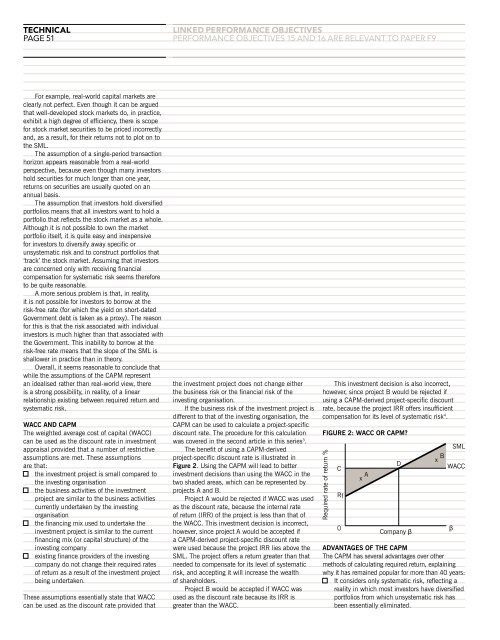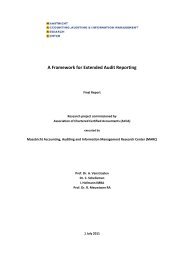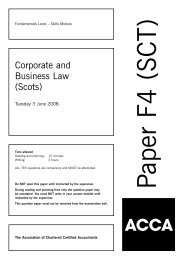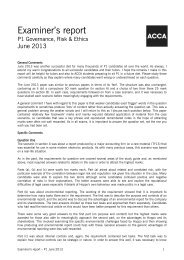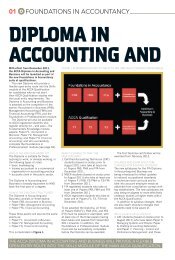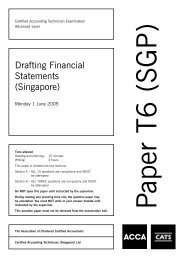CAPM: THEORY, ADVANTAGES, AND DISADVANTAGES - ACCA
CAPM: THEORY, ADVANTAGES, AND DISADVANTAGES - ACCA
CAPM: THEORY, ADVANTAGES, AND DISADVANTAGES - ACCA
You also want an ePaper? Increase the reach of your titles
YUMPU automatically turns print PDFs into web optimized ePapers that Google loves.
technical<br />
page 51<br />
For example, real-world capital markets are<br />
clearly not perfect. Even though it can be argued<br />
that well-developed stock markets do, in practice,<br />
exhibit a high degree of efficiency, there is scope<br />
for stock market securities to be priced incorrectly<br />
and, as a result, for their returns not to plot on to<br />
the SML.<br />
The assumption of a single-period transaction<br />
horizon appears reasonable from a real-world<br />
perspective, because even though many investors<br />
hold securities for much longer than one year,<br />
returns on securities are usually quoted on an<br />
annual basis.<br />
The assumption that investors hold diversified<br />
portfolios means that all investors want to hold a<br />
portfolio that reflects the stock market as a whole.<br />
Although it is not possible to own the market<br />
portfolio itself, it is quite easy and inexpensive<br />
for investors to diversify away specific or<br />
unsystematic risk and to construct portfolios that<br />
‘track’ the stock market. Assuming that investors<br />
are concerned only with receiving financial<br />
compensation for systematic risk seems therefore<br />
to be quite reasonable.<br />
A more serious problem is that, in reality,<br />
it is not possible for investors to borrow at the<br />
risk-free rate (for which the yield on short-dated<br />
Government debt is taken as a proxy). The reason<br />
for this is that the risk associated with individual<br />
investors is much higher than that associated with<br />
the Government. This inability to borrow at the<br />
risk-free rate means that the slope of the SML is<br />
shallower in practice than in theory.<br />
Overall, it seems reasonable to conclude that<br />
while the assumptions of the <strong>CAPM</strong> represent<br />
an idealised rather than real-world view, there<br />
is a strong possibility, in reality, of a linear<br />
relationship existing between required return and<br />
systematic risk.<br />
WACC <strong>AND</strong> <strong>CAPM</strong><br />
The weighted average cost of capital (WACC)<br />
can be used as the discount rate in investment<br />
appraisal provided that a number of restrictive<br />
assumptions are met. These assumptions<br />
are that:<br />
the investment project is small compared to<br />
the investing organisation<br />
the business activities of the investment<br />
project are similar to the business activities<br />
currently undertaken by the investing<br />
organisation<br />
the financing mix used to undertake the<br />
investment project is similar to the current<br />
financing mix (or capital structure) of the<br />
investing company<br />
existing finance providers of the investing<br />
company do not change their required rates<br />
of return as a result of the investment project<br />
being undertaken.<br />
These assumptions essentially state that WACC<br />
can be used as the discount rate provided that<br />
linked performance objectives<br />
performaNce obJectives 15 aNd 16 are reLevaNt to paper f9<br />
the investment project does not change either<br />
the business risk or the financial risk of the<br />
investing organisation.<br />
If the business risk of the investment project is<br />
different to that of the investing organisation, the<br />
<strong>CAPM</strong> can be used to calculate a project-specific<br />
discount rate. The procedure for this calculation<br />
was covered in the second article in this series 3 .<br />
The benefit of using a <strong>CAPM</strong>-derived<br />
project-specific discount rate is illustrated in<br />
Figure 2. Using the <strong>CAPM</strong> will lead to better<br />
investment decisions than using the WACC in the<br />
two shaded areas, which can be represented by<br />
projects A and B.<br />
Project A would be rejected if WACC was used<br />
as the discount rate, because the internal rate<br />
of return (IRR) of the project is less than that of<br />
the WACC. This investment decision is incorrect,<br />
however, since project A would be accepted if<br />
a <strong>CAPM</strong>-derived project-specific discount rate<br />
were used because the project IRR lies above the<br />
SML. The project offers a return greater than that<br />
needed to compensate for its level of systematic<br />
risk, and accepting it will increase the wealth<br />
of shareholders.<br />
Project B would be accepted if WACC was<br />
used as the discount rate because its IRR is<br />
greater than the WACC.<br />
This investment decision is also incorrect,<br />
however, since project B would be rejected if<br />
using a <strong>CAPM</strong>-derived project-specific discount<br />
rate, because the project IRR offers insufficient<br />
compensation for its level of systematic risk 4 .<br />
FIGURE 2: WACC OR <strong>CAPM</strong>?<br />
Required rate of return %<br />
C<br />
Rf<br />
0<br />
A<br />
x<br />
Company β<br />
SML<br />
B<br />
x<br />
WACC<br />
<strong>ADVANTAGES</strong> OF THE <strong>CAPM</strong><br />
The <strong>CAPM</strong> has several advantages over other<br />
methods of calculating required return, explaining<br />
why it has remained popular for more than 40 years:<br />
It considers only systematic risk, reflecting a<br />
reality in which most investors have diversified<br />
portfolios from which unsystematic risk has<br />
been essentially eliminated.<br />
D<br />
β


